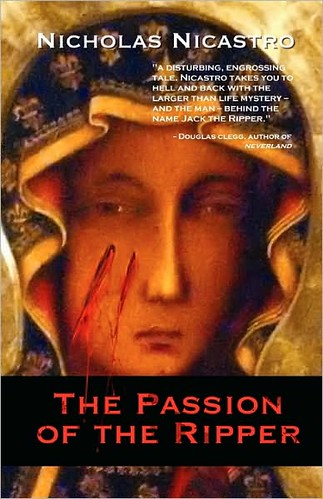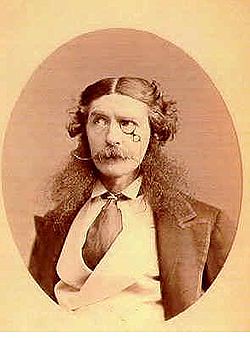
Here’s a novel about Jack the Ripper which right away shows its literary aspirations. The first section of the novel, which pitches the reader immediately into the poor districts of London of the day where the Ripper murders occurred, is titled, “The Morlocks.” Astute readers will recognize that title as a nod to H. G. Wells’ The Time Machine---and in fact Wells himself appears as a character in this novel.
Immediately below that allusive title is an appropriate quote from Shelley: “Hell is a city much like London, a populous and smoky city.” And the opening line of the novel may remind many of T. S. Eliot’s opening to “The Love Song of J. Alfred Prufrock” when Mr. Nicastro opens with: “The guts of London are laid out as if on a surgeon’s table.”
From there on in, the novel is all Nick Nicastro as the London of 1888 is well evoked by the novelist, the author of five previous historical novels on various topics. The writer tells us that his aim in writing The Passion of the Ripper was to create “a different kind of Ripper story: not a whodunit, but a naturalistic exploration of the man, his city, and his times. It tells this well-known story from the inside out, from the points of view of the killer, the cops, and his final victim. It is the result of extensive research on the subject, but the aim is a kind of truth beneath and beyond the facts.”
It is not too forthcoming to reveal that the Ripper of the story is identified pretty early on in the novel when the scene shifts from London to Poland and we get a glimpse of the early life of an assistant surgeon named Severin Klosowski, who would later emigrate to London to work as a barber (being unable to qualify for licensure as a medical man), taking the name George Chapman. While in his native Poland, the suspect is portrayed as a man with strange sexual proclivities in the presence of an icon of the Black Madonna of Czestochowa—whose bloody-cheeked image is featured on the cover of Nicastro’s novel.
George Chapman is not a mainstream candidate for the unknown murderer of 1888 that we know today as Jack the Ripper. The infamous serial killer either gave himself the name or else possibly he received it--for better or worst and for all time--from an enterprising London journalist desiring to “hype” up the stories by writing the “Ripper letters” written to the authorities in which the writer claimed to be the bloody murderer.
Chapman was ultimately arrested for the poisoning murder of several common-law wives and was hanged in 1903. Although the main detective on the 1888 case, Scotland Yard’s famed Chief Inspector Frederick George Abberline, by 1903 retired, supposedly said to his former subordinate, Inspector George Godley, “You’ve got Jack the Ripper at last!”, most experts on the Ripper case point out the large gulf in nature between the types of crimes attributed to Chapman and those of the Ripper: Chapman’s disposal of his “wives” secretive and duplicitous and the Ripper crimes bloody murders and mutilations done on the public streets of the East End of London; the Chapman crimes done to women the murderer knew and lived with, and the Ripper crimes done to street prostitutes that the killer probably did not know beforehand.
Nick Nicastro expertly captures the passion of the moment of the murders and the psychology of the man who committed them. Whether the barber Polish barber was Jack the Ripper or not, the novel makes for an enthralling and informative read. The book is available through Barnes & Noble and Amazon.
* Here's what Lord Dundreary thinks of George Chapman's candidacy as Jack the Ripper. . . .

That's actor Edward Askew Sothern in the role of Lord Dundreary in "Our American Cousin," the play the Lincolns went to see on the fateful night of April 14, 1865 at Ford's Theatre, Washington, D.C., when President Lincoln was shot by John Wilkes Booth. Sothern is wearing the "Dundreary whiskers" he made famous.
The above review (without the Dundreary afterword I might add!) is a taste of what is on offer in the Fall issue of Loch Raven Review just released. I join my fellow editors Jim Doss and Dan Cuddy in unveiling the issue. Check it out at http://www.lochravenreview.net/2010Fall/
Loch Raven Review Fall 2010 contains:
Poetry by Eric Basso, Carol Bindel, Shirley J. Brewer, Joe Conard, Tobi Cogswell, Stan Galloway, Peter D. Goodwin, Lois Marie Harrod, Carl Kavadlo, May Kuroiwa, Michael Monroe, Joseph Murphy, Alan C. Reese, Susan Louise Sgroi, and Philip Wexler
Fiction by Paul Beckman, Carl Kavadlo, Elisavietta Ritchie, and Anna Sykora.
Review by Dan Cuddy of White Asparagus by D.R. Belz, and reviews by Christopher T. George of The Slow Creek and Other Stories by F. de Sales Meyers; The Passion of the Ripper by Nicholas Nicastro; Memoir of a Dog by Frank Prem with illustrations by Leanne Murphy; Palette of Life by Virginia Bates; Street Magic by Grant D. McLeman; and Manorborn: The Water Issue edited by Margaret S. Mullins.
For writers interesting in submitting to Loch Raven Review, the deadline for the Spring issue, which posts in March, is February 28th. (Reading period February 15th - March 15th).
Monday, November 29, 2010
The Passion of the Ripper by Nicholas Nicastro
Posted by
Christopher T. George
at
8:00 PM
2
comments
![]()
Subscribe to:
Posts (Atom)